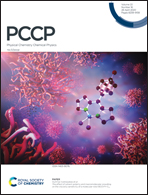Strong enhancement of gold nanoparticle chemiresistor response to low-partitioning organic analytes induced by pre-exposure to high partitioning organics†
Abstract
Exposing a thiol-functionalised gold nanoparticle film chemiresistor to methanol in aqueous solution results in only a small electric current response as the thiol ligand/water partition coefficient of methanol is small, leading to only minor swelling of the chemiresistor film. Nevertheless, the current response to methanol can be enhanced if the chemiresistor becomes pre-exposed to a molecule with a large ligand/water partition coefficient P (e.g. octane with Po = 104.3). The large response enhancement is achieved because methanol, when added to an aqueous solution of octane, lowers the large initial partition coefficient of octane. Octane exiting the thiol ligands then leads to strong film shrinkage resulting in a relative current change much greater than the one otherwise induced by methanol alone. This was theoretically modelled for octane and heptane (Ph = 103.6). A strong response enhancement to methanol (>20 times) was observed experimentally by exposure to 2 ppm octane compared to direct testing of methanol in aqueous solution. Besides octane and heptane, molecules with P > 107 (e.g. permethrin) can theoretically be used to provide enhancement factors of several orders of magnitude. For practical reasons, heptane and octane saturate more quickly, thus enabling more rapid detection of methanol than higher P organic molecules.



 Please wait while we load your content...
Please wait while we load your content...